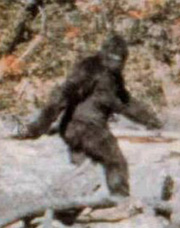Bigfoot

Bigfoot is one of a number of names given to a large hairy foul-smelling bipedal hominid—an enormous ape-like creature that walks upright similar to humans. Its existence has not been proven because there is scant physical evidence. The information available is largely anecdotal.
Bigfoot, known in Canada as Sasquatch, has been spotted in many parts of the world: For example, in Nepal and Tibet the creature is called Yeti or the Abominable Snowman; Australians call theirs Yowie. The Johor Hominid has been sighted in Malaysia, Viet Nam reports a Jungle Man, and in China, it’s a Wild Man. There are frequent Bigfoot sightings in Ontario and British Columbia and in the Pacific northwest of the U.S., although sightings have been reported in all 50 states and several countries in addition to those named.
Legends of this mysterious and feared creature date back to the pre-Columbian era and have been passed along through generations of indigenous American civilizations, sometimes as folk-lore. In some early cultures Bigfoot inspired respect and awe, while in others it was considered a predatory cannibal or scary monster. Although Bigfoot had different names in every culture — including Big Man, Yeahoh, Rugaru, and Tse’nahaha—there is a thread of similarity in its descriptions by those in many parts of the world who claim to have spotted Bigfoot.
The search for, and study of, Bigfoot is a science of its own, called cryptozoology. According to Merriam-Webster, cryptozoology is the study of and search for animals and especially legendary animals, usually in order to evaluate the possibility of their existence.1 The field is not accepted as mainstream science due to the lack of conclusive physical evidence, and cryptozoologists are usually regarded by other scientists with skepticism, if not ridicule.
That did not deter a virtual community of journalists, scientists, and others from creating the Web-based Bigfoot Field Research Organization in 1995 to build a database of reported Bigfoot sightings in the U.S. and Canada and other countries who report a sighting. BFRO’s stated mission is “to resolve the mystery surrounding the Bigfoot phenomenon.”2 The researchers who comprise the BFRO claim they evaluate sightings, conduct field and laboratory investigations when warranted, and publish their findings. However, the group has its detractors, who claim BFRO’s science is sloppy and exploitative, and that it is prone to sensationalizing its reports.3
The debate over Bigfoot’s existence has dragged on for at least 175 years, perhaps longer. Mainstream scientists argue that until substantial evidence is gathered that cannot be explained by any other means, the creature is likely a member of the ape family, perhaps a Gigantophithecus or a Paranthropus, or a kind of bear. As for reported sightings, they cite that any evidence purported to be proof of Bigfoot’s existence could be fraudulent, nothing more than a hoax. Their position is based on the scientific method of discovery.4
Supporters of the notion of Bigfoot point to widely scattered reports of a smelly 7 to 10-foot-tall monster from all over the world, including from cultures that could not possibly be co-conspirators in a hoax. Up to two-foot long footprints have been seen and witnessed on separate occasions in a variety of locations. A few tufts of fur and bits of bone have reportedly been found near the site of a reported appearance of Bigfoot that have not been identified definitively as belonging to a known animal. There is also a bit of film made in 1967 of a female Bigfoot in motion, called the Patterson-Gimlin footage (AKA Patterson-Gimlin Film or PGF).5
One of the better-known yet controversial imprint captures of an apparently reclining Bigfoot resulted in the plaster Skookum Cast, made on Sept. 22, 2000, during a BFRO expedition to the Skookum Meadows area of the Gifford Pinchot National Forest in the state of Washington.6
Among those who acknowledge the possibility of Bigfoot include Henry Gee, editor of Nature magazine; Dr. Jane Goodall; anthropologist Carleton S. Coon; John Willison Green, author of Sasquatch: The Apes Among Us; American scientists Geoffrey Bourne and Grover Krantz; and British anthropologist John Russell Napier, who wrote Bigfoot: The Sasquatch and Yeti in Myth and Reality.
Skeptics include zoologist John Crane, anthropologist David Gaegling, primatologist Russell Mitteremeier, and paleoanthropologist Milford Wolpoff. Seattle artist Matt Crowley created a cast identical to one claimed to be an authentic footprint, proving to many that it and its unscrupulous promoter were fraudulent.7
1. http://www.merriam-webster.com/
2. http://www.bfro.net/REF/aboutbfr.asp
3. http://www.angelfire.com/wa2/bfro/ and http://americanbigfoot.blogspot.com/2006/11/my-tenure-with-bfro-part-iii.html
4. http://www.ncsu.edu/labwrite/res/res-glossary.html
5. http://www.bigfootencounters.com/articles/gps.htm
6. http://www.bigfootencounters.com/articles/skookum_cast2000.htm
7. http://www.csicop.org/sb/2006-09/bigfoot.html#author
Other resources used:
http://encarta.msn.com, “Abominable Snowman”; Microsoft® Encarta® Online Encyclopedia 2007; http://encarta.msn.com; 1997-2007 Microsoft Corporation. All Rights Reserved.
http://en.wikipedia.org/wiki/Sasquatch
http://en.wikipedia.org/wiki/Pre-Columbian
http://en.wikipedia.org/wiki/Skookum_cast
http://en.wikipedia.org/wiki/Yeti
